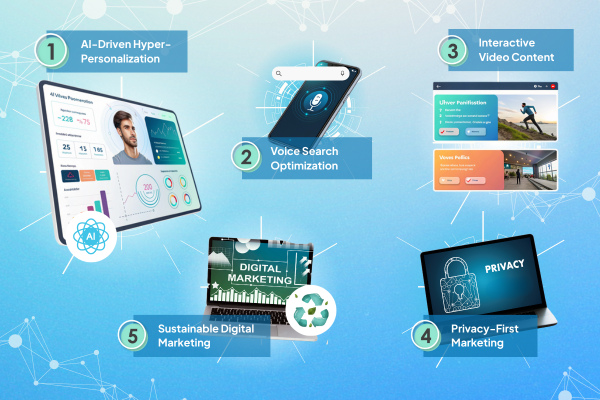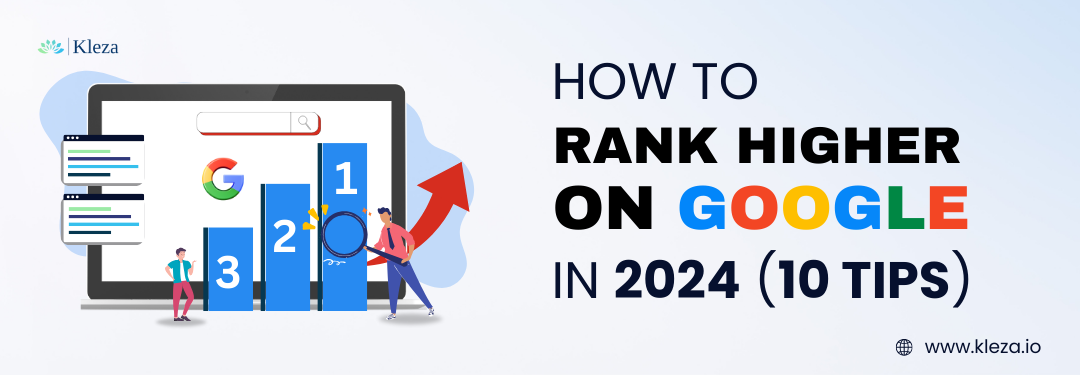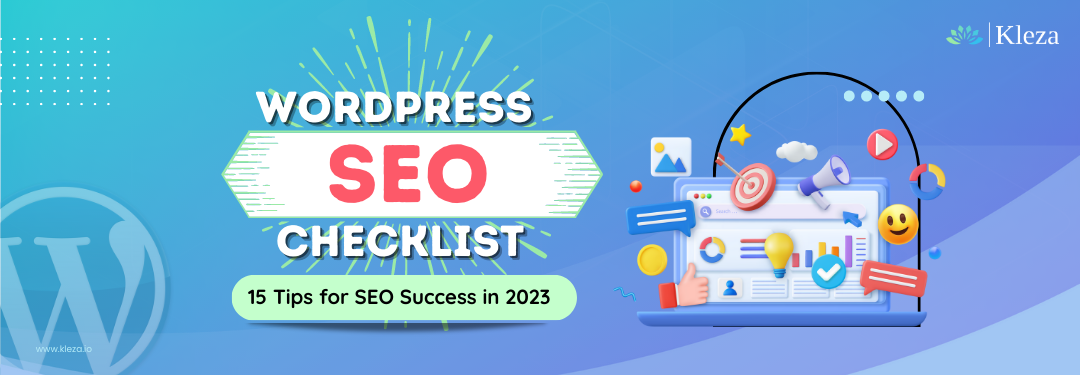
Top 10 New Digital Marketing Trends to Watch For in 2025
Adapt to survive- this is the reality of today’s digital marketing world. Every few weeks, we get to see new digital marketing trends that rewrite the algorithm, causing your digital content to either engage or topple consumer attention within minutes. So, are you playing by the rule book or stuck in limbo, unable to take your brand ahead? For marketers and leaders, clinging to yesterday’s playbook isn’t just risky—it’s corporate self-sabotage. It is high time that as a successful digital marketer in 2025, you rethink your planned strategies and ask yourself– will these be able to captivate, convert, and command loyalty in an era where audiences don’t just scroll—they demand magic?
In this blog, let’s dive deep into the top 10 digital marketing trends that are set to shape 2025. They’re not just here to stay but they’ll also define the next decade of the industry. Arm yourself with these useful insights that can help reshape your digital marketing strategy and stay ahead of your competition.
Consumer-Centric Digital Marketing Trends that Drive Impact

- AI-Driven Hyper-Personalization
Artificial Intelligence is no longer a buzzword; it’s the backbone of modern digital marketing trends. This year, AI will power hyper-personalized experiences that go far beyond addressing customers by name. Think real-time product recommendations, dynamic pricing based on browsing history, and content tailored to individual preferences—all delivered at the right moment.
Why It Matters:
- 80% of consumers are more likely to buy from brands offering personalized experiences.
- AI reduces guesswork, enabling precision targeting that boosts ROI.
Actionable Tips:
- Invest in AI tools like Google’s Analytics AI or Adobe Sensei to analyze customer data.
- Use dynamic content blocks in emails and landing pages.
- Segment audiences based on behavior, not just demographics.
- Voice Search Optimization
With over 1 in 5 US adults owning a smart speaker optimizing for voice search is non-negotiable. Brands looking for new digital marketing trends can adopt conversational AI chatbots that respond to voice queries which are longer and often local (e.g., “Where’s the nearest vegan café open now?”).
Why It Matters:
- 27% of global internet users use voice search on mobile.
- Brands that ignore voice search risk losing visibility in a hands-free, voice-first world.
Actionable Tips:
- Target long-tail keywords and natural language phrases.
- Optimize for local SEO with Google My Business updates.
- Create FAQ pages that answer specific, voice-driven questions.
- Interactive Video Content
Forget static videos—2025 is all about interactive content where viewers influence the narrative. Both B2B and B2C marketers can use interactive short-form video content as part of their strategy; such as choose-your-own-adventure ads, shoppable videos, and live polls during streams. These digital marketing trends are surely here to stay!
Why It Matters:
- Interactive videos achieve more engagement than static videos.
- They bridge the gap between entertainment and conversion.
Actionable Tips:
- Use platforms like YouTube Interactive or Vimeo OTT for branching scenarios.
- Embed shoppable tags in product demos.
- Host live Q&A sessions with clickable CTAs.
- Privacy-First Digital Marketing Trends
With third-party cookies phased out and regulations like GDPR tightening, marketers must pivot to privacy-first strategies. Consumers demand transparency, and brands that respect data privacy will win trust. This digital marketing trend is a must to adopt as it helps you boost your relationship with the consumer, by fostering security and trust.
Why It Matters:
- 75% of consumers feel that tech companies have too much control over their data.
- 80% of consumers believe that brand purchase history is the most acceptable data to collect.
Actionable Tips:
- Build email lists with gated, high-value content (e.g., webinars, eBooks).
- Use contextual advertising instead of behavioral tracking.
- Implement clear consent forms and data usage policies.

- Sustainable Digital Marketing Trends
Eco-conscious consumers are scrutinizing brands’ environmental impact—including digital footprints. Sustainable digital marketing trends focus on reducing carbon emissions (e.g., energy-efficient websites) and promoting ethical practices.
Why It Matters:
- 66% of consumers consider sustainability when making purchases.
- Green brands enjoy higher loyalty and advocacy.
Actionable Tips:
- Optimize media files to reduce page load emissions and boost website ranking.
- Highlight sustainability efforts in environmental campaigns conducted.
- AR/VR Experiences: Immersive Storytelling
Augmented Reality (AR) and Virtual Reality (VR) are digital marketing trends that are transforming how consumers interact with brands. To understand this concept better, imagine having the ability to access virtual try-ons for makeup, AR-guided product demos, or VR real estate tours—all from a smartphone.
Why It Matters:
- 71% of consumers prefer AR experiences when shopping.
- Immersive tech reduces return rates and boosts confidence.
Actionable Tips:
- As part of digital advertising, launch Instagram or Snapchat AR filters for product trials.
- Create VR showrooms for high-value items (e.g., cars, furniture).
- Collaborate with platforms like Meta Horizon for virtual events.
- Data-Driven Predictive Analytics
Predictive analytics uses historical data and machine learning to forecast digital marketing trends, customer behavior, and social media marketing campaign outcomes. This basically means you’re not just shooting arrows in the darkness, rather your brand is analyzing consumer insights and behavior to design marketing campaigns that can drive conversions.
Why It Matters:
- Companies using predictive analytics see better lead generation.
- Anticipate churn, demand spikes, and content trends.
Actionable Tips:
- Deploy tools like Google Analytics 4 to score your social media strategy.
- Train teams to interpret predictive insights.
- A/B test campaigns based on forecasted preferences.
- Conversational Marketing
We can already sense the power of advanced AI chatbots and digital messaging apps while using several websites on a day-to-day basis. To join the digital marketing trend, an increasing number of brands have adopted the language of these bots and integrated it with Google PPC ads to generate sales. These bots resolve queries instantly, book appointments, and even upsell—all while mimicking human empathy.
Why It Matters:
- 64% of consumers value 24/7 support
- Instant engagement shortens sales cycles.
Actionable Tips:
- Integrate chatbots on websites and WhatsApp.
- Use sentiment analysis to escalate complex issues to humans.
- Personalize chatbot scripts with humor or brand voice.
Micro-moments—when consumers turn to devices for quick answers—are critical. Think “I-want-to-know,” “I-want-to-go,” or “I-want-to-buy” moments. Winning these seconds requires a smart content marketing approach. If you wish to join this digital marketing trend, you need to learn to recognize the micro-moments that are critical to consumer decision-making and then deploy a befitting approach.
Why It Matters:
- 96% of people use smartphones to accomplish immediate tasks.
- Brands that act fast gain lifelong customers.
Actionable Tips:
- Optimize for mobile-first, snackable content.
- Use Google Ads real-time bidding for intent keywords.
- Create “how-to” videos and instant checkout options.
- Influencer marketing
An existing digital marketing trend that is evolving this year is that influencer marketing will pivot toward AI-driven micro-communities and virtual creators who resonate with hyper-niche audiences. Audiences will crave unfiltered, relatable User-generated content—whether it’s a TikTok creator reviewing eco-friendly products in real-time or a virtual influencer hosting a VR pop-up concert.
Why It Matters:
- Over 70% of Gen Z consumers trust influencers over traditional ads.
- Virtual influencers reduce branding costs by 40% while offering 24/7 global reach.
Actionable Tips:
- Leverage nano-influencers for niche markets
- Experiment with virtual influencers for futuristic campaigns
- Co-create AR experiences: Let influencers design Instagram/TikTok filters that showcase your product in action.
Ace your Marketing Strategy, Learn and Embrace Digital Marketing Trends
We’re almost through the first half of 2025, but that doesn’t mean it’s too late to spin around your marketing strategy and lead the second half. The digital marketing trends we’ve explored are not just fleeting buzzwords but game changers that are reshaping how brands engage, innovate, and thrive in an increasingly connected world. Brands now have unprecedented tools to captivate audiences and have their undivided attention. Imagine virtual storefronts where customers try products in 3D. But these innovations are only useful if you know how to leverage them strategically. Plus, it’s significant to remember that at its core, marketing has to remain profoundly human-centric, prioritizing empathy, inclusivity, and authentic storytelling to forge emotional connections in a digital-first era.
Push yourself to think: Is my brand ready to meet audiences where they’ll be—not just physically, but emotionally and digitally engaged? It’s time to experiment, upskill, and future-proof your strategy. Embrace these digital marketing trends not as challenges, but as invitations to innovate, inspire, and lead in a market where change is the only constant. However, we do understand that navigating these changes alone can be a difficult task. That’s where Kleza Solutions comes in.
Our diverse range of services include:
- Tailored digital marketing services to align with your brand’s vision.
- Innovative website and mobile app development to showcase your brand to the world
- Cutting-edge and innovative E-Commerce solutions to take your brand places
- Expert-led operational outsourcing services to help you focus on what you do best!
- Efficient Remote IT Services to reduce your process turnaround time
Don’t just try to keep up- lead the change with a strong vision. It is essential to gain a clear understanding about which of these digital marketing trends is more suited to your brand. For professional support, choose us for mapping your marketing strategy and aligning it with the latest digital marketing trends. Witness how our expertise pens down your brand’s success story. Contact us today to take your brand on a new pathway of excellence.
Resources
- https://www.forbes.com/councils/forbesbusinesscouncil/2024/11/13/digital-marketing-trends-for-2025-and-beyond/
- https://www.salesforce.com/resources/articles/customer-expectations/
- https://www.statista.com/chart/23943/share-of-us-adults-who-own-smart-speakers/#:~:text=Data%20from%20the%20Statista%20Global,said%20they%20owned%20the%20system.
- https://www.yaguara.co/voice-search-statistics/
- https://learn.g2.com/video-commerce
- https://explodingtopics.com/blog/data-privacy-stats
- https://www.forbes.com/councils/forbesagencycouncil/2024/03/12/augmented-reality-a-game-changer-in-next-gen-marketing-strategies/
- https://developers.meta.com/horizon/documentation/native/ps-events
- https://medium.com/@kaanalperucan/the-power-of-predictive-analytics-how-data-driven-forecasting-is-transforming-business-decision-63b4da389b00
- https://www.forbes.com/councils/forbesagencycouncil/2022/06/09/how-to-use-ab-testing-and-consumer-insights-to-tweak-campaigns/
- https://www.prdaily.com/the-4-categories-of-micro-moments/
- https://inflownetwork.com/influencer-trends-in-2025/





